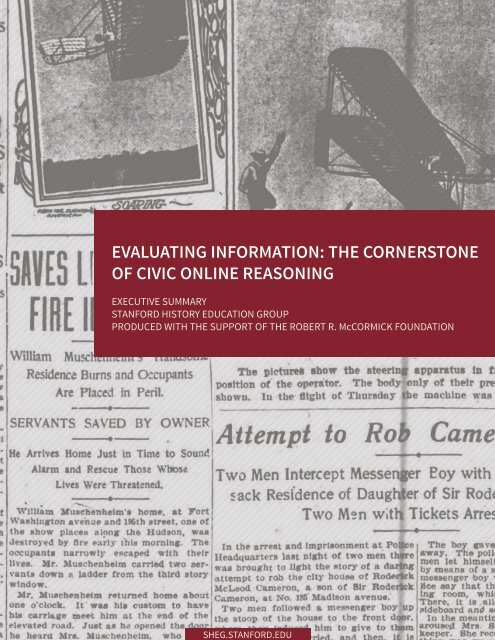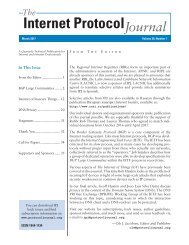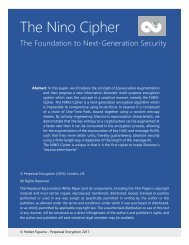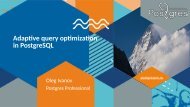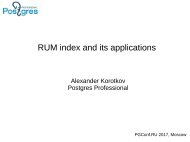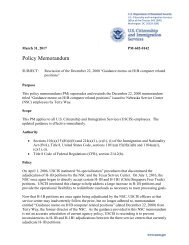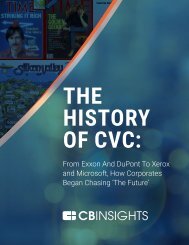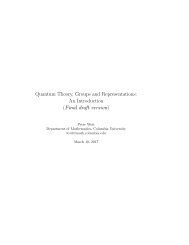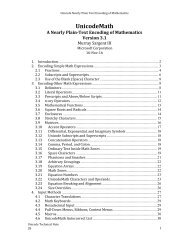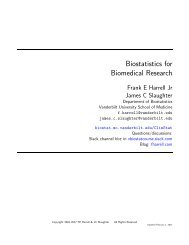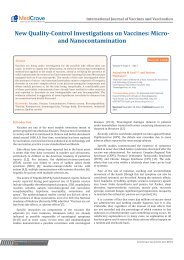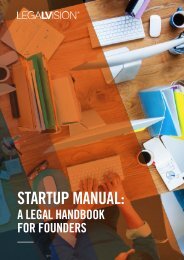EVALUATING INFORMATION THE CORNERSTONE OF CIVIC ONLINE REASONING
2feQVUk
2feQVUk
Create successful ePaper yourself
Turn your PDF publications into a flip-book with our unique Google optimized e-Paper software.
SHEG.STANFORD.EDU<br />
<strong>EVALUATING</strong> <strong>INFORMATION</strong>: <strong>THE</strong> <strong>CORNERSTONE</strong><br />
<strong>OF</strong> <strong>CIVIC</strong> <strong>ONLINE</strong> <strong>REASONING</strong><br />
EXECUTIVE SUMMARY<br />
STANFORD HISTORY EDUCATION GROUP<br />
PRODUCED WITH <strong>THE</strong> SUPPORT <strong>OF</strong> <strong>THE</strong> ROBERT R. McCORMICK FOUNDATION
4<br />
8<br />
9<br />
10<br />
11<br />
15<br />
16<br />
17<br />
18<br />
20<br />
21<br />
23<br />
24<br />
EXECUTIVE SUMMARY<br />
HOME PAGE ANALYSIS<br />
Task<br />
Overview<br />
Rubric<br />
<strong>EVALUATING</strong> EVIDENCE<br />
Task<br />
Overview<br />
Rubric<br />
CLAIMS ON SOCIAL MEDIA<br />
Task<br />
Overview<br />
Rubric
Over the last year and a half, the Stanford History Education Group has prototyped, field<br />
tested, and validated a bank of assessments that tap civic online reasoning—the ability to<br />
judge the credibility of information that floods young people’s smartphones, tablets, and<br />
computers.<br />
Between January 2015 and June 2016, we administered 56 tasks to students across 12<br />
states. In total, we collected and analyzed 7,804 student responses. Our sites for fieldtesting<br />
included under-resourced, inner-city schools in Los Angeles and well-resourced<br />
schools in suburbs outside of Minneapolis. Our college assessments, which focused on<br />
open web searches, were administered online at six different universities that ranged from<br />
Stanford, an institution that rejects 94% of its applicants, to large state universities that<br />
admit the majority of students who apply.<br />
In what follows, we provide an overview of what we learned and sketch paths our<br />
future work might take. We end by providing samples of our assessments of civic online<br />
reasoning.
EXECUTIVE SUMMARY<br />
Evaluating Information: The Cornerstone of Civic Online Reasoning<br />
November 22, 2016<br />
<strong>THE</strong> BIG PICTURE<br />
When thousands of students respond to<br />
dozens of tasks there are endless variations.<br />
That was certainly the case in our experience.<br />
However, at each level—middle school, high<br />
school, and college—these variations paled<br />
in comparison to a stunning and dismaying<br />
consistency. Overall, young people’s ability to<br />
reason about the information on the Internet<br />
can be summed up in one word: bleak.<br />
Our “digital natives” may be able to flit<br />
between Facebook and Twitter while<br />
simultaneously uploading a selfie to Instagram<br />
and texting a friend. But when it comes to<br />
evaluating information that flows through<br />
social media channels, they are easily duped.<br />
We did not design our exercises to shake out<br />
a grade or make hairsplitting distinctions<br />
between a “good” and a “better” answer.<br />
Rather, we sought to establish a reasonable<br />
bar, a level of performance we hoped was<br />
within reach of most middle school, high<br />
school, and college students. For example, we<br />
would hope that middle school students could<br />
distinguish an ad from a news story. By high<br />
school, we would hope that students reading<br />
about gun laws would notice that a chart came<br />
from a gun owners’ political action committee.<br />
And, in 2016, we would hope college students,<br />
who spend hours each day online, would look<br />
beyond a .org URL and ask who’s behind a site<br />
that presents only one side of a contentious<br />
issue. But in every case and at every level,<br />
we were taken aback by students’ lack of<br />
preparation.<br />
For every challenge facing this nation, there<br />
are scores of websites pretending to be<br />
something they are not. Ordinary people once<br />
relied on publishers, editors, and subject<br />
matter experts to vet the information they<br />
consumed. But on the unregulated Internet,<br />
all bets are off. Michael Lynch, a philosopher<br />
who studies technological change, observed<br />
that the Internet is “both the world’s best factchecker<br />
and the world’s best bias confirmer—
often at the same time.”1 Never have we<br />
had so much information at our fingertips.<br />
Whether this bounty will make us smarter<br />
and better informed or more ignorant and<br />
narrow-minded will depend on our awareness<br />
of this problem and our educational<br />
response to it. At present, we worry that<br />
democracy is threatened by the ease at which<br />
disinformation about civic issues is allowed to<br />
spread and flourish.<br />
SEQUENCE <strong>OF</strong> ACTIVITIES<br />
Our work went through three phases during<br />
the 18 months of this project.<br />
Prototyping assessments. Our development<br />
process borrows elements of “design thinking”<br />
from the world of product design, in which a<br />
new idea follows a sequence of prototyping,<br />
user testing, and revision in a cycle of<br />
continuous improvement.2 For assessment<br />
development, this process is crucial, as it<br />
is impossible to know whether an exercise<br />
designed by adults will be interpreted similarly<br />
by a group of 13-year-olds.<br />
In designing our assessments, we directly<br />
measured what students could and could not<br />
do. For example, one of our tasks sent high<br />
school and college students to<br />
MinimumWage.com, ostensibly a fair broker<br />
for information on the relationship between<br />
minimum wage policy and employment<br />
rates. The site links to reputable sources like<br />
the New York Times and calls itself a project<br />
of the Employment Policies Institute, a nonprofit<br />
organization that describes itself as<br />
sponsoring nonpartisan research. In open<br />
web searches, only nine percent of high<br />
school students in an Advanced Placement<br />
history course were able to see through<br />
MinimumWage.com’s language to determine<br />
that it was a front group for a D.C. lobbyist,<br />
or as Salon’s headline put it, “Industry PR<br />
STANFORD HISTORY EDUCATION GROUP<br />
Firm Poses as Think Tank.”3 Among college<br />
students the results were actually worse:<br />
Ninety-three percent of students were snared.<br />
The simple act of Googling “Employment<br />
Policies Institute” and the word “funding”<br />
turns up the Salon article along with a host<br />
of other exposés. Most students never moved<br />
beyond the site itself.4<br />
Validation. To ensure that our exercises<br />
tapped what they were supposed to (rather<br />
than measuring reading level or test taking<br />
ability), we engaged in extensive piloting,<br />
sometimes tweaking and revising our exercises<br />
up to a half-dozen times. Furthermore, we<br />
asked groups of students to verbalize their<br />
thinking as they completed our tasks. This<br />
allowed us to consider what is known as<br />
cognitive validity, the relationship between<br />
what an assessment seeks to measure and<br />
what it actually does.5<br />
Field Testing. We drew on our extensive<br />
teacher networks for field-testing. The<br />
Stanford History Education Group’s online<br />
Reading Like a Historian curriculum6 is<br />
used all over the country and has been<br />
adopted by Los Angeles Unified School<br />
District,7 the second largest school district<br />
in the U.S. With help from teachers in L.A.<br />
and elsewhere, we collected thousands<br />
of responses and consulted with teachers<br />
about the appropriateness of the exercises.<br />
Together with the findings from the cognitive<br />
validity interviews, we are confident that our<br />
assessments reflect key competencies that<br />
students should possess.<br />
OVERVIEW <strong>OF</strong> <strong>THE</strong> EXERCISES<br />
We designed, piloted, and validated fifteen<br />
assessments, five each at middle school,<br />
high school, and college levels. At the middle<br />
school level, where online assessment is in<br />
its infancy, we designed paper-and-pencil<br />
5<br />
EXECUTIVE SUMMARY
measures using digital content. We used<br />
screen shots of Slate’s landing page to assess<br />
students’ ability to distinguish between a<br />
news item and an ad. Similarly, we used<br />
screen shots of tweets, Facebook posts, and<br />
a reproduction of CNN’s website in crafting<br />
other exercises. We are mindful of the criticism<br />
of using paper-and-pencil measures to assess<br />
students’ ability to judge online sources. At the<br />
same time, there is evidence from the OECD<br />
that important abilities for evaluating online<br />
sources can be measured offline.8 Even more<br />
crucial in our decision, however, was the hope<br />
that our assessments would be used in underresourced<br />
schools where online assessment<br />
often remains a remote possibility. Our middle<br />
school assessments provide easy-to-use<br />
measures that teachers and others can use<br />
to gauge students’ basic skills. At the high<br />
school level, we designed more complex tasks<br />
that asked students to reason about multiple<br />
sources; at the college level, the exercises<br />
were administered online. When students are<br />
working at advanced levels, there is nothing<br />
to prevent the high school exercises from<br />
being used with middle school students, or the<br />
college exercises from being used with high<br />
school students.<br />
Summaries of each of our exercises are below.<br />
The exercises in bold appear in the following<br />
pages.<br />
Middle School<br />
1) News on Twitter: Students consider<br />
tweets and determine which is the most<br />
trustworthy.<br />
2) Article Analysis: Students read a sponsored<br />
post and explain why it might not be<br />
reliable.<br />
3) Comment Section: Students examine a<br />
post from a newspaper comment section<br />
and explain whether they would use it in a<br />
research report.<br />
STANFORD HISTORY EDUCATION GROUP<br />
4) News Search: Students distinguish between<br />
a news article and an opinion column.<br />
5) Home Page Analysis: Students identify<br />
advertisements on a news website.<br />
High School<br />
1) Argument Analysis: Students compare and<br />
evaluate two posts from a newspaper’s<br />
comment section.<br />
2) News on Facebook: Students identify<br />
the blue checkmark that distinguishes a<br />
verified Facebook account from a fake one.<br />
3) Facebook Argument: Students consider the<br />
relative strength of evidence that two users<br />
present in a Facebook exchange.<br />
4) Evaluating Evidence: Students decide<br />
whether to trust a photograph posted on<br />
a photo-sharing website.<br />
5) Comparing Articles: Students determine<br />
whether a news story or a sponsored post<br />
is more reliable.<br />
College<br />
1) Article Evaluation: In an open web search,<br />
students decide if a website can be trusted.<br />
2) Research a Claim: Students search online to<br />
verify a claim about a controversial topic.<br />
3) Website Reliability: Students determine<br />
whether a partisan site is trustworthy.<br />
4) Social Media Video: Students watch an<br />
online video and identify its strengths and<br />
weaknesses.<br />
5) Claims on Social Media: Students read a<br />
tweet and explain why it might or might<br />
not be a useful source of information.<br />
6<br />
EXECUTIVE SUMMARY
NEXT STEPS<br />
We envision several next steps that build on<br />
what we have accomplished. These include:<br />
Assessment for Learning. Although our<br />
tasks could be used in a variety of ways, we<br />
think they are powerful tools for classroom<br />
instruction. Rather than simply serving as<br />
assessments of learning, they can also be<br />
assessments for learning, or what are known<br />
as “formative assessments.” Teachers can use<br />
our tasks to track student understanding and<br />
to adjust instruction accordingly. Similarly,<br />
teachers can use these exercises as the<br />
basis for broader lessons about the skills<br />
these tasks measure. We also hope to create<br />
accompanying materials that help teachers<br />
incorporate these tasks into the flow of<br />
classroom instruction.<br />
Curriculum development. Teachers also<br />
need curriculum focused on developing<br />
students’ civic online reasoning. Drawing on<br />
our experience in developing the Reading Like<br />
a Historian curriculum, we have begun to pilot<br />
lesson plans that can be used in conjunction<br />
with our assessments. In the coming months,<br />
we will be working closely with teachers to<br />
refine these materials and to implement them<br />
in classrooms.<br />
Awareness of the Problem. When we began<br />
our work we had little sense of the depth of the<br />
problem. We even found ourselves rejecting<br />
ideas for tasks because we thought they would<br />
be too easy. Our first round of piloting shocked<br />
us into reality. Many assume that because<br />
young people are fluent in social media they<br />
are equally savvy about what they find there.<br />
Our work shows the opposite. We hope to<br />
produce a series of high-quality web videos to<br />
showcase the depth of the problem revealed<br />
by students’ performance on our tasks and<br />
demonstrate the link between digital literacy<br />
and citizenship. By drawing attention to this<br />
connection, a series of videos could help to<br />
mobilize educators, policymakers, and others<br />
to address this threat to democracy.<br />
1<br />
Michael P. Lynch, “Googling is Believing: Trumping the Informed<br />
Citizen,” New York Times, March 9, 2016. Retrieved from http://<br />
opinionator.blogs.nytimes.com/2016/03/09/googling-is-believingtrumping-the-informed-citizen/<br />
2<br />
Tim Brown, “Design Thinking,” Harvard Business Review 86, no. 6<br />
(2008): 84-95.<br />
3<br />
Lisa Graves, “Corporate America’s New Scam: Industry P.R. Firm<br />
Poses as Think Tank!” Salon, November 2013. Retrieved from http://<br />
www.salon.com/2013/11/13/corporate_americas_new_scam_<br />
industry_p_r_firm_poses_as_think_tank/<br />
4<br />
We recommended that students spend about ten minutes on this<br />
task, but there was nothing that prevented them from spending<br />
more, as the exercise was self-administered. We can say with some<br />
assurance that the issue here was not one of running out of time.<br />
5<br />
James W. Pellegrino, Naomi Chudowsky, and Robert Glaser, eds.,<br />
Knowing What Students Know: The Science and Design of Educational<br />
Assessment. (Washington: National Academies Press, 2001).<br />
6<br />
http://sheg.stanford.edu<br />
7<br />
achieve.lausd.net/page/5965<br />
8<br />
Organisation for Economic Cooperation and Development, Students,<br />
Computers and Learning: Making the Connection (Paris: OECD<br />
Publishing, 2015).<br />
STANFORD HISTORY EDUCATION GROUP<br />
7<br />
EXECUTIVE SUMMARY
HOME PAGE ANALYSIS
1. This is / is not (circle one) an<br />
advertisement because_________<br />
____________________________<br />
____________________________<br />
____________________________<br />
____________________________<br />
____________________________<br />
____________________________<br />
Here is the home page of Slate.com. Some of the<br />
things that appear on Slate.com are news stories,<br />
and others are advertisements.<br />
H STORY<br />
EDUCATION GROUP<br />
Slate<br />
2. This is / is not (circle one) an<br />
advertisement because_________<br />
____________________________<br />
____________________________<br />
____________________________<br />
____________________________<br />
____________________________<br />
____________________________<br />
3. This is / is not (circle one) an<br />
advertisement because_________<br />
____________________________<br />
____________________________<br />
____________________________<br />
____________________________<br />
____________________________<br />
____________________________<br />
SPONSORED CONTENT<br />
The Real Reasons<br />
Women Don’t Go<br />
Into Tech<br />
When Is<br />
Cheryl’s<br />
Birthday?<br />
A simple chart that<br />
explains the logic<br />
problem that spread<br />
around the world.<br />
By Laura Bradley and<br />
Marie Lindemann<br />
MOST RECENT<br />
SEE ALL ><br />
24M AGO - JORDAN WEISSMAN - 1M TO READ<br />
Forget Steak and Seafood: Here’s How Welfare<br />
Recipients Actually Spend Their Money<br />
30M AGO - BEN MATHIS-LILLEY<br />
Buckingham Palace Guard Falls Over (Video)<br />
45M AGO - L. BRADLEY & A.M. LINDEMANN - 2M<br />
TO READ<br />
When is Cheryl’s Birthday? Solving a Logic<br />
Problem That Quickly Spread Around the World.
OVERVIEW<br />
Many news organizations have turned to native advertising as a source of revenue. By<br />
definition, native advertising tries to sell or promote a product in the guise of a news story.<br />
Native advertising makes it difficult for unsuspecting readers to know if and when there is an<br />
ulterior motive behind the information they encounter.<br />
In this assessment, students are presented with the home page of Slate magazine’s website,<br />
which includes both news items and advertisements. The task assesses students’ ability<br />
to distinguish between an article and an advertisement. Students must evaluate three<br />
different sections of the web page—a traditional advertisement, a news story, and a native<br />
advertisement—and determine the nature of each. Successful students understand the<br />
different forms that advertising can take and identify both traditional and native advertising.<br />
They are also able to explain the features that distinguish a news story from an ad.<br />
We piloted several drafts of this task with 350 middle school students. We completed final<br />
piloting with 203 middle school students. Results indicated that students were able to identify<br />
traditional news stories and traditional advertisements: more than three-quarters of the<br />
students correctly identified the traditional advertisement and the news story. Unfortunately,<br />
native advertising proved vexing for the vast majority of students. More than 80% of students<br />
believed that the native advertisement, identified by the words “sponsored content,” was<br />
a real news story. Some students even mentioned that it was sponsored content but still<br />
believed that it was a news article. This suggests that many students have no idea what<br />
“sponsored content” means and that this is something that must be explicitly taught as early<br />
as elementary school.<br />
STANFORD HISTORY EDUCATION GROUP<br />
10<br />
HOME PAGE ANALYSIS
RUBRIC<br />
MASTERY<br />
Student correctly identifies the item as an ad or non-ad and provides<br />
coherent reasoning.<br />
EMERGING<br />
Student correctly identifies the item as an ad or non-ad but provides<br />
limited or incoherent reasoning.<br />
BEGINNING<br />
Student incorrectly identifies the item as an ad or non-ad.<br />
SAMPLE RESPONSES<br />
TRADITIONAL AD: GOTHAM WRITERS<br />
MASTERY<br />
These students correctly categorized this as an ad based on several of its features.<br />
It has the ”Ad Choices ” and ”Stop Seeing this Ad ” buttons<br />
in the top right corner.<br />
It has a coupon code , a big company logo , and has the words<br />
”limited time offer.”<br />
In the left side there is something that says save $20, and usuallymoneyis<br />
involved if people are selling something.<br />
STANFORD HISTORY EDUCATION GROUP<br />
11<br />
HOME PAGE ANALYSIS
EMERGING<br />
This student engages in circular reasoning.<br />
It is an advertisement because it advertises something .<br />
This student chooses an irrelevant factor: how “useful” the content seems as a reason it is an<br />
advertisement.<br />
•It is an advertisement because there’s no<br />
”really useful” thing on it.<br />
NEWS ARTICLE: CALIFORNIA ALMONDS<br />
MASTERY<br />
Student correctly identifies this story as an article and identifies several features of the article that<br />
helped her categorize it as an article.<br />
There is no little blue X, it has an author of the article, and it<br />
doesn’t say it is sponsored content.<br />
EMERGING<br />
Student identifies a feature that may or may not indicate its status as an ad.<br />
It is not an advertisement because it does not have a blue button on top.<br />
STANFORD HISTORY EDUCATION GROUP<br />
12<br />
HOME PAGE ANALYSIS
BEGINNING<br />
This student argues that the story is an advertisement.<br />
It is an advertisement because they are trying to persuade<br />
people that almonds aren’t bad and that you should buy them .<br />
NATIVE AD: WOMEN IN TECH<br />
MASTERY<br />
This student explains that the words “sponsored content” signify that the story is an advertisement.<br />
Despite that the advertisement takes the form of an article, it is an ad as<br />
it states ”Sponsored Content,” meaning the content is created by a company<br />
who paid money to the publication.<br />
EMERGING<br />
This student correctly identifies the story but offers an inaccurate idea about what being<br />
“sponsored” means.<br />
It is being sponsored by the website to promote their company.<br />
STANFORD HISTORY EDUCATION GROUP<br />
13<br />
HOME PAGE ANALYSIS
BEGINNING<br />
This student argues that this story must be an article because it lacks traditional features of an ad.<br />
There is nothing to suggest that something is sold. No money,deals,<br />
etc.It sounds like an article.<br />
This student notices the words “sponsored content” but still argues that it is an article.<br />
It is another article. Even if it’s marked ”sponsored content,” it is<br />
another article.<br />
STANFORD HISTORY EDUCATION GROUP<br />
14<br />
HOME PAGE ANALYSIS
<strong>EVALUATING</strong> EVIDENCE
H STORY<br />
EDUCATION GROUP<br />
On March 11, 2011, there was a large nuclear disaster at the Fukushima Daiichi<br />
Nuclear Power Plant in Japan. This image was posted on Imgur, a photo<br />
sharing website, in July 2015.<br />
Fukushima Nuclear Flowers<br />
by pleasegoogleShakerAamerpleasegoogleDavidKelly • a month ago<br />
Not much more to say, this is what happens when flowers get nuclear birth defects<br />
Does this post provide strong evidence about the conditions near the<br />
Fukushima Daiichi Power Plant? Explain your reasoning.
OVERVIEW<br />
Given the vast amount of information available online, students need to be able to distinguish<br />
between legitimate and dubious sources. Students need to ask a basic question: Where did this<br />
document I’m looking at come from? This task assesses whether students will stop to ask this<br />
question when confronted with a vivid photograph. Students are presented with a post from<br />
Imgur, a photo sharing website, which includes a picture of daisies along with the claim that the<br />
flowers have “nuclear birth defects” from Japan’s Fukushima Daiichi nuclear disaster.<br />
Although the image is compelling and tempting to accept at face value, successful students will<br />
argue that the photograph does not provide strong evidence about conditions near the nuclear<br />
power plant. Students may question the source of the post, arguing that we know nothing<br />
about the credentials of the person who posted this photo (especially since it appears on a site<br />
where anyone can upload a photo). Alternatively, students may point out that the post provides<br />
no proof that the picture was taken near the power plant or that nuclear radiation caused the<br />
daisies’ unusual growth.<br />
Various drafts of this task were piloted with 454 high school students. The final version was given<br />
to 170 high school students. By and large, students across grade levels were captivated by the<br />
photograph and relied on it to evaluate the trustworthiness of the post. They ignored key details,<br />
such as the source of the photo. Less than 20% of students constructed “Mastery” responses, or<br />
responses that questioned the source of the post or the source of the photo. On the other hand,<br />
nearly 40% of students argued that the post provided strong evidence because it presented<br />
pictorial evidence about conditions near the power plant. A quarter of the students argued that<br />
the post did not provide strong evidence, but only because it showed flowers and not other<br />
plants or animals that may have been affected by the nuclear radiation.<br />
STANFORD HISTORY EDUCATION GROUP<br />
17<br />
<strong>EVALUATING</strong> EVIDENCE
RUBRIC<br />
MASTERY<br />
Student argues the post does not provide strong evidence and questions<br />
the source of the post (e.g., we don’t know anything about the author<br />
of the post) and/or the source of the photograph (e.g., we don’t know<br />
where the photo was taken).<br />
EMERGING<br />
Student argues that the post does not provide strong evidence, but the<br />
explanation does not consider the source of the post or the source of the<br />
photograph, or the explanation is incomplete.<br />
BEGINNING<br />
Student argues that the post provides strong evidence or uses incorrect<br />
or incoherent reasoning.<br />
SAMPLE RESPONSES<br />
MASTERY<br />
This student questions the source of the photo, arguing that there is no way to know whether the<br />
photo was actually taken near the plant or if the mutations were a result of nuclear radiation.<br />
No, it does not provide strong evidence about the conditions near<br />
the Fukushima Daiichi power plant. It does not provide strong<br />
evidence because it could just be a mutation in the plant. There also<br />
isn’t evidence that this is near the Fukushima Daiichi power plant.<br />
This student questions the source of the post, arguing that we know nothing about the poster’s<br />
credentials or whether the evidence was doctored.<br />
No, itdoes not really provide strong evidence . A photo posted by a stranger<br />
online has little credibility.This photo could very easily be Photoshopped<br />
or stolen from another completelydifferent source; we have no idea given<br />
this information, which makes it an unreliable source.<br />
STANFORD HISTORY EDUCATION GROUP<br />
18<br />
<strong>EVALUATING</strong> EVIDENCE
EMERGING<br />
This student begins to question both the photo and the source of the post but does not fully explain<br />
his thinking.<br />
This post does not provide strong evidence about<br />
conditions near the power plant. They just put a picture<br />
of a flower. Plus the poster has a strange username.<br />
This student critiques the evidence by arguing that it could have been digitally altered but does not<br />
offer any further explanation or critique of the evidence.<br />
No, because this picture could be Photoshopped.<br />
BEGINNING<br />
This student accepts the evidence at face value, arguing that it provides visual proof of the effects<br />
of the nuclear disaster.<br />
This post does provide strong evidence because it shows how the<br />
small and beautiful things were affected greatly, that theylook and<br />
grow completelydifferent than theyare supposed to. Additionally, it<br />
suggests what such a disaster could do to humans.<br />
Although this student argues that the post does not provide strong evidence, she still accepts the<br />
photo as evidence and simply wants more evidence about other damage caused by the radiation.<br />
No, this photo does not provide strong evidence because it only shows a<br />
small portion of the damage and effects caused by the nuclear disaster.<br />
STANFORD HISTORY EDUCATION GROUP<br />
19<br />
<strong>EVALUATING</strong> EVIDENCE
CLAIMS ON SOCIAL MEDIA
H STORY<br />
EDUCATION GROUP
The assessment directs students to this webpage:
OVERVIEW<br />
Twitter is filled with individuals and groups seeking to further their agendas. In order to navigate<br />
this sea of information, students need to be able to weigh the relative strengths and weaknesses<br />
of tweets as sources of information. Specifically, students need to consider the sources of tweets<br />
and the information contained in them.<br />
This task presents students with a tweet from the liberal advocacy organization MoveOn.org that<br />
reads: “New polling shows the @NRA is out of touch with gun owners and their own members.”<br />
The tweet includes a graphic that asserts, “Two out of three gun owners say they would be more<br />
likely to vote for a candidate who supported background checks.” The tweet contains a link to a<br />
press release by the poll’s sponsor, the Center for American Progress, another liberal advocacy<br />
organization. Both the news release and the tweet indicate that Public Policy Polling conducted<br />
the poll in November 2015. Students are asked why this tweet might and might not be a useful<br />
source of information. Strong responses will note that the tweet may provide useful information<br />
given that it is based on a poll conducted by a professional polling firm. At the same time,<br />
students must acknowledge how the political motivations of the Center for American Progress<br />
and MoveOn.org, both of which support stronger gun control measures, may have shaped the<br />
structure of the poll and how its results were publicized.<br />
We piloted this task with 44 undergraduate students at three universities. Results indicated that<br />
students struggled to evaluate tweets. Only a few students noted that the tweet was based on<br />
a poll conducted by a professional polling firm and explained why this would make the tweet<br />
a stronger source of information. Similarly, less than a third of students fully explained how<br />
the political agendas of MoveOn.org and the Center for American Progress might influence the<br />
content of the tweet. Many students made broad statements about the limitations of polling or<br />
the dangers of social media content instead of investigating the particulars of the organizations<br />
involved in this tweet.<br />
STANFORD HISTORY EDUCATION GROUP<br />
23<br />
CLAIMS ON SOCIAL MEDIA
An interesting trend that emerged from our think-aloud interviews was that more than half of<br />
students failed to click on the link provided within the tweet. Some of these students did not click<br />
on any links and simply scrolled up and down within the tweet. Other students tried to do outside<br />
web searches. However, searches for “CAP” (the Center for American Progress’s acronym, which<br />
is included in the tweet’s graphic) did not produce useful information. Together these results<br />
suggest that students need further instruction in how best to navigate social media content,<br />
particularly when that content comes from a source with a clear political agenda.<br />
RUBRIC<br />
Question 1: Why might this tweet be a useful source?<br />
MASTERY<br />
Student fully explains that the tweet may be useful because it includes<br />
data from a poll conducted by a polling firm.<br />
EMERGING<br />
Student addresses the polling data and/or the source of the polling<br />
data but does not fully explain how those elements may make the tweet<br />
useful.<br />
BEGINNING<br />
Student does not address the polling data or the source of the polling<br />
data as a reason the tweet may be useful.<br />
STANFORD HISTORY EDUCATION GROUP<br />
24<br />
CLAIMS ON SOCIAL MEDIA
SAMPLE RESPONSES<br />
MASTERY<br />
This student identifies the polling firm and provides evidence of the firm’s reliability.<br />
The polling information which the tweet references was collected by Public Policy Polling,<br />
which appears to have a fairly strong accuracy record, though with a Democratic bent (e.g.,<br />
Wall Street Journal article: http://www.wsj.com/articles/SB122592455567202805)<br />
EMERGING<br />
This student references the poll but does not explain why that makes the tweet a useful source of<br />
information.<br />
The photo used in this tweet was compiled from a public policy polling survey.<br />
BEGINNING<br />
This student focuses on the tweet’s appearance rather than its content.<br />
It could be useful because a graphic with a strong message can be enlightening or more likely<br />
thought provoking.<br />
This student equates Twitter followers with trustworthiness.<br />
MoveOn.org has a large following on Twitter.<br />
STANFORD HISTORY EDUCATION GROUP<br />
25<br />
CLAIMS ON SOCIAL MEDIA
Question 2: Why might this tweet not be a useful source?<br />
MASTERY<br />
Student fully explains how the political motivations of the organizations<br />
involved may have influenced the content of the tweet and/or poll, which<br />
may make the tweet less useful.<br />
EMERGING<br />
Student addresses the source of the tweet or the source of the news release<br />
but does not fully explain how those elements may make the tweet less<br />
useful.<br />
BEGINNING<br />
Student does not address the source of the tweet or the source of the news<br />
release as reasons the tweet may be less useful.<br />
SAMPLE RESPONSES<br />
MASTERY<br />
This student explains how MoveOn.org’s work as a political advocacy organization might influence<br />
the tweet’s contents.<br />
According to the MoveOn.org Wikipedia page, MoveOn.org is a “progressive public policy”<br />
group and thus will most likely be against most any media or information distributed by the<br />
NRA. The criticisms section of the Wikipedia page cited more than one instance of MoveOn.org<br />
distorting the truth and even attempting to alter Google searches for their own benefit. I would<br />
seek a different source to know NRA members’ opinions on background checks.<br />
STANFORD HISTORY EDUCATION GROUP<br />
26<br />
CLAIMS ON SOCIAL MEDIA
EMERGING<br />
The student suggests that the tweet is politically motivated but does not explain how this might<br />
influence the content of the tweet.<br />
Although MoveOn.org claims to be independent, they also were paid to work on Obama’s<br />
campaign so are clearly Democrat-oriented, and the NRA members tend to be Republicans<br />
(http://front.moveon.org/about/#.V0NYK5MrLBI).<br />
BEGINNING<br />
This student focuses on the nature of Twitter rather than the source of the tweet.<br />
Twitter is a social platform built for sharing opinions, and though there are plenty of news<br />
organizations sharing facts on Twitter, I’d be more likely to trust an article than a tweet.<br />
STANFORD HISTORY EDUCATION GROUP<br />
27<br />
CLAIMS ON SOCIAL MEDIA


